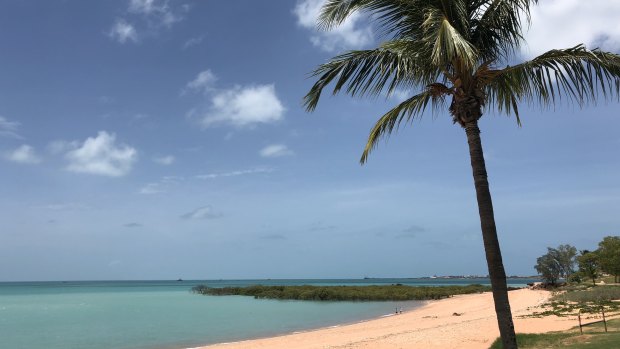- Analysis
- National
- WA
- Kimberley in crisis
This was published 6 years ago
Kimberley in crisis: Paradise lost as Broome battles the booze
By Kate Hedley
It’s a bright Broome morning with a big, blue, cloudless sky, and I’ve just seen a kid defecate on the town oval.
He’s about six or seven years old and, once his business is done, he wanders back to sit with a group of women who are drinking in the shade outside the Broome Visitor Centre.

It looks beautiful, but tourist hot-spot Broome is plagued by all the problems endemic in WA's Kimberley region.Credit: Kate Hedley
It’s 11am. I’ve been in town about 15 minutes.
This was not in the brochure.
Welcome to paradise
The last time I was in Broome was 25 years ago. Like so many who come to this Kimberley town, which welcomes the itinerant and tourist dollar, I lived and worked here for a while before moving on.
Whenever someone asks me what it was like to live in one of Australia’s most beautiful – and most marketed – tourist hotspots, I always tell them the truth: it’s impossibly gorgeous to look at, but the social problems in the town far outweigh any tourist attraction.
There was shocking domestic violence and child abuse; there were huge groups of people drinking all day on the oval before they passed out on the footpath; and there were people with nowhere to live, "camping" in the dunes near Chinatown and sleeping in parks and reserves.
More than two decades on, I’d hoped these issues had been resolved, or that there’d at least been some improvement.
That there has been neither resolution nor improvement – it’s worse now than I remember it being in the `90s – is not only horrifically sad, it’s bordering on criminal neglect.
Findings released last week by State Coroner Ros Fogliani following an inquest into the suicides – including two in Broome – of 13 Indigenous children and young people in the Kimberley laid bare the "urgent need to understand the deep inequalities giving rise to the current poor state of wellbeing of Aboriginal people in the Kimberley region".
The coroner referred to the "tragic events" as having been shaped by the "crushing effects of intergenerational trauma and poverty upon entire communities".
You don't have to look far to see it for yourself.
But you do have to get off your backside.
A matter of urgency
A couple of weeks ago, when half the country was engaged in the annual argument over whether we should change the date of Australia Day, Kerri-Anne Kennerley created a media firestorm when she dared to question if any of those calling for this date change had actually visited remote Indigenous communities “where children, babies, five-year-olds are being raped”.
“These people are desperate for help and they’re not getting it,” she said.
Now, whether or not you think the date of Australia Day should be changed out of respect to the country’s first inhabitants, as I happen to believe, wasn’t Kennerley only trying to highlight the absolute irrelevance of an argument bereft of any actual action?
It’s very easy to sit in our comfortable homes in big cities and comment on the plight of a group of people plagued by endemic social dysfunction and think we’ve done our bit by signing a change.org petition or changing our Facebook profile picture to an Aboriginal flag.
But how many of us have seen for ourselves the living conditions and intergenerational trauma cited by the coroner that prompted the need for – another – inquest into Indigenous youth suicide?
How many have made the effort to not only try to understand why so many Aboriginal kids are taking their own lives, but to actually do something about it?
Even the fact that anyone has done this is still not cause for congratulations.
Because here we are again. Another inquest, 10 years after the last one. Whatever we’re doing to try to help this situation is not working. We are failing these people.
And how this is not a national emergency is an absolute disgrace.
You can’t look away
Thomas King runs the Kullari Patrol in Broome. The Kullari van picks up intoxicated people and makes sure they either get home, or to the local "sober-up" shelter, or at least to somewhere safe.
Mr King does not think there will be a need for another inquest into Indigenous youth suicides in 10 years. He thinks it will be much sooner. And he is perfectly placed to make such a reckoning. He’s seen it all on the streets of the tropical town, and what he’s seen isn’t pretty.
“This is a town rife with hopelessness,” Mr King tells me. I believe him. I can see it with my own eyes.
Liquor restrictions in surrounding towns and communities have made Broome a hub for those who want to drink.
I met some of them over the past few days: alcoholics for whom one drink is both too much and never enough.
Their stories make for heartbreaking reading. But they’re not unique to Broome.
It’s the context of this setting that is particularly jarring: crystal-clear blue water, pearls and palm trees sell one side of the town, while these people remain just far enough from our peripheral vision that we can justify averting our gaze.
Over the next couple of days you will get to read the stories of those who live every day on the very edge of our society, yet find themselves at the centre of this crisis. You’ll also get to know Mr King better, and meet the people who run the drop-in centre for Broome’s kids.
These are the people making positive changes in the town.
But God, they’ve got a fight on their hands.